13. Reporting Tools

When it comes to managing your business, the more data you have, the better. PayPal offers a number of detailed business reports that track all aspects of the transactions for which PayPal handles payment processing. You can view this information in a variety of reports.
These reports let you analyze your business on a daily, monthly, or even yearly basis. Want to know how your sales are doing? Want to know how profitable your PayPal sales are, after all fees have been subtracted? PayPal has a report. You should be able to generate a PayPal report that presents only the data that matters to you.
Understanding PayPal’s Reporting Tools
In addition to the detailed transaction history discussed in the previous chapter, PayPal offers a variety of reporting tools to help you better measure and manage your business. These tools—actually, a series of different reports—provide the information you need to identify and analyze important trends in your business.
PayPal’s Reporting Tools let you better understand your customers’ buying behavior by analyzing your revenue sources. They also automate time-consuming bookkeeping tasks and accurately settle and reconcile all PayPal-related transactions.
What Reporting Tools are available? In addition to the History log (discussed in Chapter 12, “Managing Business Info and Data”), PayPal offers the following:
• Reporting Center, which provides a quick summary of recent sales data.
• Monthly Sales Report, which details information for all payments and refunds on a day-to-day basis for a given month—and then lets you view all transactions for a given day.
• Monthly Financial Summary, which provides a snapshot of PayPal account activity for the selected month.
• Yearly Financial Summary, which creates a detailed financial statement for the given year.
• Recurring Payments – User Profiles, which displays details for all Recurring Payments profiles (with activity in the last 30 days).
• Case Report, which details all buyer complaint and chargeback cases.
• Inventory and Profit & Loss Report, which details current inventory levels and generates basic profit and loss data.
In addition, PayPal lets you search your account history for specific transactions, via the Transaction Finder. Use this tool when you need more details about a given transaction.
PayPal also offers a Settlement and Reconciliation System, available to high-volume Business accounts only. This system automatically settles your PayPal payments and helps you avoid shipping items with incomplete or uncleared payments.
Your Business Overview
The Business Overview page is your home base for PayPal’s Reporting Tools. Click the My Account tab, hover over the History subtab, and select Reports. Or access this page—and all of the reporting tools—at http://business.paypal.com.
As you can see in Figure 13.1, your Business Overview page provides a quick overview of various key metrics as well as links to other reports and useful information.
Figure 13.1. Your Business Overview page.
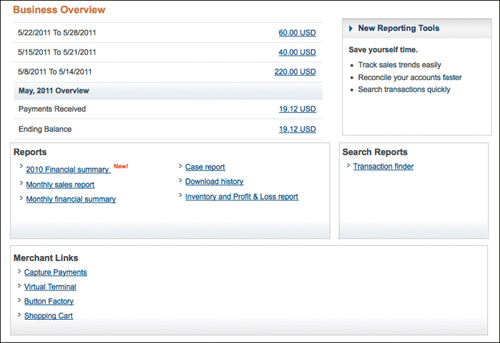
Examine the Weekly Sales section for the past three weeks to determine sales trends—that is, whether your sales are increasing or decreasing over time.
At the top of your Business Overview page is a list of your weekly sales for the past three weeks. Click the amount to the right of any week to view the Sales Report for each day in that week.
Returning to your Business Overview, the next thing you see is information about the previous month’s activities. This lists payments received and your ending PayPal account balance for the month. Click either the amount (Ending Balance or Payments Received) to view the Monthly Financial Summary page. This displays your Financial Statement for that month with controls to change the date range displayed.
Beneath this presentation of key metrics is the Reports section, which links to PayPal’s various business reports. To the right of the Reports section is the Search Reports section; click the link here to search your payment history for specific transactions.
Viewing Sales Reports
PayPal’s Sales reports provide detailed data about all payments and refunds processed on a given day. There are a number of ways to access the Sales reports; the easiest approach is to open your Business Overview page and then click Monthly Sales Report in the Reports section.
Viewing the Monthly Sales Report
After you select a date range (month-to-date by default) and currency, PayPal displays the Monthly Sales Report shown in Figure 13.2. This report displays a summary of activity for each day listed, including the following data:
• Payments Received, the number of individual payments registered.
• Amount Received, the total amount of money received in payment.
• Payment Fees, the amount of PayPal transaction fees charged.
• Refunds Sent, the number of individual refunds processed.
Figure 13.2. The Monthly Sales Report.
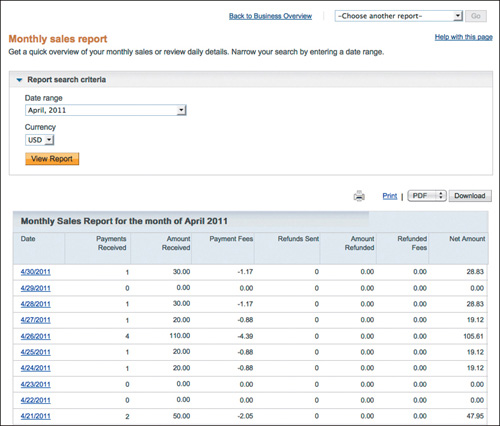
• Amount Refunded, the total amount of money refunded.
• Refunded Fees, the amount of PayPal fees refunded.
• Net Amount, the net amount of dollars transacted—amount received less payment fees less amount refunded plus refunded fees.
Peruse the Monthly Sales Report to quickly see your best-performing days and worst-performing days in terms of sales.
The Monthly Sales Report displays the default date range (month-to-date) and the default currency—until and unless you change either parameter. To display data from previous months, simply select a month from the Date Range list at the top of the report page. To change the currency displayed, select a new currency from the Currency list. Click the View Report button to redisplay the summary page after you make changes.
Downloading the Report
You can view the Monthly Sales Report onscreen, or download a copy in Microsoft Excel, tab-delimited, comma-delimited, or PDF format for further evaluation. To download this report, select a file format from the Download list at the top right corner of the page, and then click the Download button. If you select any of the non-PDF file formats, you can then import the downloaded file into Excel to manipulate as you please.
You can download most business reports the same way, using the Download button at the top of the individual report page.
Viewing Details for a Specific Day
To view a more detailed report for a specific day, click the link for that date in the Date column. The resulting report, like the one shown in Figure 13.3, provides more detailed views of the payments and refunds that were recorded on that particular day. There is an entry for each payment received and refund sent. For each entry you see the following data:
Figure 13.3. A report showing sales on a specific day.

• Date, when the transaction was concluded.
• Type, which describes the type of transaction.
• Email, of the customer for that transaction.
• Gross Amount, the total dollar amount of the transaction.
• Fee Amount, the amount of PayPal fees charged to this transaction.
• Net Amount, the Gross Amount less the Fee Amount.
Viewing Transaction Details
To view more details about a given transaction, click the amount in the Gross Amount column for that transaction. This displays a specific Transaction Details page, like the one in Figure 13.4, which shows just about everything PayPal knows about the transaction: amount received, customer email, total amount, fee amount, net amount, time and date transacted, the customer’s shipping address, and so on.
Figure 13.4. A typical Transaction Details page.
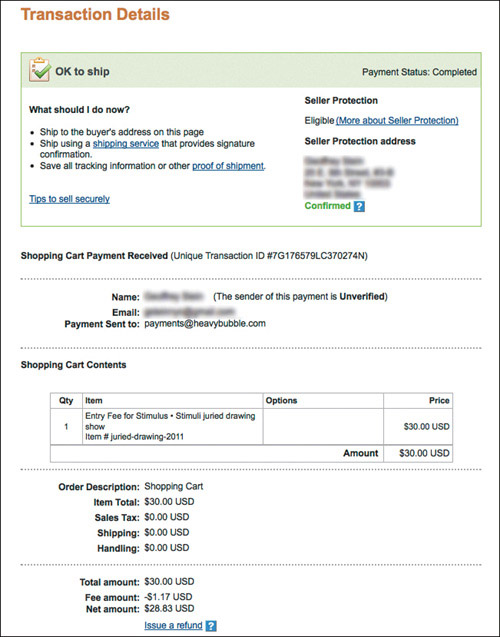
Viewing Financial Summary Reports
Next up are PayPal’s financial summary reports. The Monthly Financial Summary report is a high-level overview of key transaction categories (sales activity, fees, disputes, and so on); it’s a great report for viewing your various PayPal-related fees for the month. The corresponding Transaction Details report provides a line-by-line accounting of all transactions for the given time frame. Both are ideal reports to provide to your accountant—and to give you bird’s-eye and detailed views of how your business is doing.
Viewing the Monthly Financial Summary
To access PayPal’s financial summary reports, go to your Business Overview page and then click the Monthly Financial Summary link in the Reports section. This opens the Monthly Financial Summary report, like the one shown in Figure 13.5.
By default, the Monthly Financial Summary report summarizes all transactions so far in the current month. To view summary information from a different month, select that month from the Date Range list at the top of the report.
The major sections of this report include:
• Balances, including the Total Balance, Available Balance, and Payables Balance on both the beginning and ending dates of the report (by default, the start of the current month and today’s date—although you can change the date range at the top of the summary page).
• Sales Activity, which summarizes all sales-related transactions, including Payments Received, Refunds Sent, and net sales (the Subtotal line).
• Fees, which summarizes all PayPal-related fees, including Payment Fees, Refunded Fees, Chargeback Fees, and Other Fees.
• Dispute Activity, which summarizes any transactions involved in customer disputes, including Chargebacks & Disputes and Dispute Reimbursements.
Figure 13.5. Your Financial Statement, displayed on the Monthly Financial Summary report (not shown in full).

• Transfers & Withdrawals, which summarizes all cash inflow and outflow to and from your PayPal account, including Currency Transfers, Transfers to PayPal Account, and Transfers from PayPal Account.
• Purchase Activity, which summarizes all payments you’ve made from your PayPal account to other sellers, including Online Payments Sent, Refunds Received, Debit Card Purchases, and Debit Card Returns.
• Holds and Releases, which summarizes transactions involved in holds, including Reserve Holds, Reserve Releases, Payment Review Holds, Payment Review Releases, Payment Holds, Payment Releases, Gift Certificate Purchases, and Gift Certificates Redeemed (not shown).
• Other Activity, including Money Market Dividends, Debit Card Cash Back, Credit Card Cash Back, and Other (not shown).
For all categories except account balances, you see two columns of numbers. The left column is for positive values (credits); the right column is for negative values (debits). The subtotal for each category (shown in the shaded row beside the category name) equals the difference between credits and debits.
As you can see, just about every category of transaction is summarized in this report. Want to know the value of gift certificates redeemed last month? Or how much you spent on purchases via debit card? Or how much you paid to PayPal in fees? Or the amount of money you refunded to customers? It’s all here in the Monthly Financial Summary report.
Viewing Transaction Details
The Monthly Financial Summary report provides a bird’s-eye view of all the income and outflow to and from your account in a given month. To view more details about each transaction processed, you need to view the Financial Summary: Transaction Details report. Display this report by clicking the View Details link at the top of the Monthly Financial Summary report.
Sometimes you don’t want to view all transactions for a given month, but only certain types of transactions—sales activity, for example, or fees. To view a Transaction Details report for a specific category, open the Monthly Financial Summary report and click the dollar value for that category.
As you can see in Figure 13.6, the Transaction Details report lists all transactions processed in the selected month. The report is wider than a typical web page; you’ll need to scroll to the right to view all data columns. These columns include the following data for each transaction:
• Date, of the transaction.
• Type, of transaction, including Payment Processed, Transfer Completed, and so forth.
Figure 13.6. The Financial Summary: Transaction Details report.
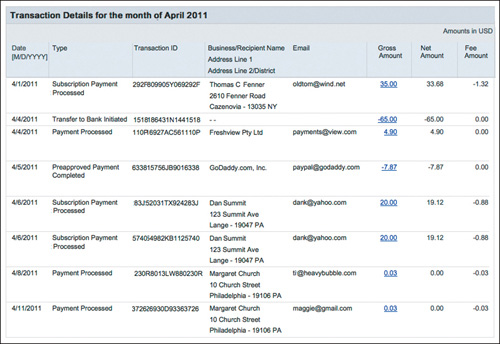
• Transaction ID, the unique identification number for this transaction.
• Business/Recipient Name/Address, the name and address of the customer (or other seller) involved in the transaction.
• Email, the customer’s email address.
• Gross Amount, the total amount of the transaction.
• Net Amount, the net amount of the transaction (gross amount less fees).
• Fee Amount, the total amount of PayPal fees charged for this transaction.
As with the Monthly Sales Reports described previously, you can also view details for any given transaction from the Financial Summary: Transaction Details. To view individual transaction details, click the dollar amount in the Gross Amount column for that transaction.
Viewing the Yearly Financial Summary
While monthly reports are great for managing a business on a continuing basis, most businesspeople also like to view financial data for an entire year at a time. PayPal provides just such a report, in the form of the Yearly Financial Summary. This report, available in PDF format only, offers a similar format to the Monthly Financial Summary report, but for the entire previous year, as shown in Figure 13.7.
To download the Yearly Financial Summary report, go to your Business Overview page and click the 20XX Financial Summary link in the Reports section. (To download the 2010 report, for example, click the 2010 Financial Summary link.) This downloads the report in PDF format to your computer; you can then use Adobe Acrobat Reader to view the report.
Figure 13.7. A portion of the Yearly Financial Summary report.

Searching Payment History
If PayPal’s various business reports don’t quite meet your needs, you can use the Transaction Finder to search for and display information about any transaction recorded. To use the Transaction Finder, follow these steps:
1. Open your Business Overview page (business.paypal.com) and click the Transaction Finder link in the Search Reports section.
2. When the Transaction Finder page appears, as shown in Figure 13.8, enter your search criteria in the Search Keyword(s) box. You can search by customer name, business name, item name, or item number.
3. Enter starting and ending dates for your search in the Date Range boxes.
4. Pull down the Transaction Type list and select which types of transactions to search: Payments Received, Refunds Sent, Fees, and so forth. (The default is All.)
5. To further refine your search results (by currency, minimum or maximum amount, or card number), click the link to filter your results and fill in the desired information.
6. Click the Search button.
Figure 13.8. Using the Transaction Finder to search for a specific transaction.
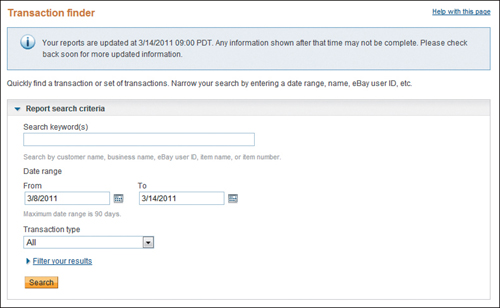
PayPal now displays a list of transactions that match your search criteria. Click the dollar amount link in the Gross Amount column to view details for a given transaction.
The Bottom Line
PayPal’s Reporting Tools are found at business.paypal.com. The most popular reports include your Business Overview page, the Monthly Sales Report, and the Monthly Financial Summary report. Using some combination of these reports—and their more detailed daily versions—you should be able to determine how well your business is doing, and observe ongoing trends.
